The Balancing Act – Between Work and Play
Click here to read the complete article
by Lauren Levy
A Motivational Article for Almost-Amateurs Who Fear that Adult Responsibilities will Interfere with their Competitive Passion!
Countless youth exhibitors dread their final year in the age division. Not only does it mark the end of an era, it also brings up a host of questions regarding their futures in the sport. Will they still be able to ride with all of the added “adult” responsibilities they will soon have? What will happen when they get full-time jobs? At times, it seems that quitting the sport is inevitable amid so many life changes, and, for some, it is. But nearly every amateur in the show pen has mastered the balance between their full-time jobs and competing. So how do they do it? Five amateur exhibitors who have built their own professional empires, but who also continue to shine in the show pen, share their secrets.
Tom Clopp
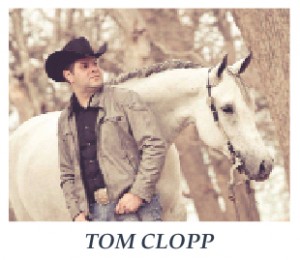 Tom Clopp works for Medline Industries Inc, a privately held manufacturer and distributor of medical supplies based out of Mundelein, Illinois. He serves as a Regional Manager, a Wound Care Specialist, and a Field Trainer to new employees. He has also been showing Quarter Horses since the sixth grade. Now 36, Clopp is having to balance his sales position with a tougher competition schedule than ever before with his horse, Clearly A Good Bar. Clopp says the most difficult aspect of balancing his work with riding is the fact that he holds a sales position. He explains, “I only make money when I’m out selling, which is hard to do when I’m out of my selling territory for a competition.” Nonetheless, he always makes it work. Clopp usually works five days a week for anywhere between 30 to 70 hours. If he has a competition coming up, he simply plans ahead and tries to adjust his work schedule to achieve all that he needs to early on in the week. Other times, Clopp flies back and forth in between shows and competitions if he really needs to go to work and cannot take vacation time off.
Tom Clopp works for Medline Industries Inc, a privately held manufacturer and distributor of medical supplies based out of Mundelein, Illinois. He serves as a Regional Manager, a Wound Care Specialist, and a Field Trainer to new employees. He has also been showing Quarter Horses since the sixth grade. Now 36, Clopp is having to balance his sales position with a tougher competition schedule than ever before with his horse, Clearly A Good Bar. Clopp says the most difficult aspect of balancing his work with riding is the fact that he holds a sales position. He explains, “I only make money when I’m out selling, which is hard to do when I’m out of my selling territory for a competition.” Nonetheless, he always makes it work. Clopp usually works five days a week for anywhere between 30 to 70 hours. If he has a competition coming up, he simply plans ahead and tries to adjust his work schedule to achieve all that he needs to early on in the week. Other times, Clopp flies back and forth in between shows and competitions if he really needs to go to work and cannot take vacation time off.
Although he says it’s “definitely distracting” to have to bring his work to competitions, he does it when necessary. “It’s hard, especially when you need internet and not all of the shows have internet, but I’ve found a pretty good balance. I’ll tell my trainer, Robin Frid, that I’m not going to come in until 10 a.m. on a certain day so I can do some work in my room. That’s the best balance you can really find, and it works out pretty well.”
In addition, Clopp proves that not only can one balance work and competing, but that it can even be done with spare time left over. Besides his full-time job and his involvement with Quarter Horses, Clopp is an avid dog rescue activist. “I help an organization in Dallas that goes to kill shelters and gets dogs that are ready to be euthanized,” he says. “I foster them and then people adopt them. I often have three, four, or even five dogs at the house that I have to take care of as well.” What has this balancing act done for Clopp? “It has made me more grounded because I’ve worked hard to be able to balance and do this,” he says. “I think it has been a good thing.”
Clopp’s advice for almost-amateurs who one day will have to balance a full-time job with competitions is this. “No matter what your career is, bust your butt, especially when you’re starting out, because the horses will always be there. If you just go and do all the horse stuff, and you’re not ready financially, you’re not going to have the horses anymore, that’s for sure.”
Beau Baird
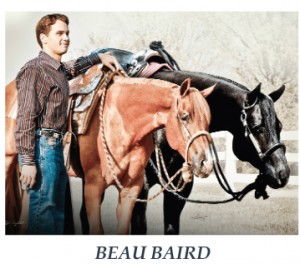 Beau Baird is an AQHA amateur exhibitor who has worked at a home health care agency as its IT Coordinator and Chief Financial Officer for over ten years. Holding such a high position within the company sometimes makes it difficult for Baird to easily get away for competitions. However, that makes the extra effort worth even more when he gets to visit his friends at shows and compete.
Beau Baird is an AQHA amateur exhibitor who has worked at a home health care agency as its IT Coordinator and Chief Financial Officer for over ten years. Holding such a high position within the company sometimes makes it difficult for Baird to easily get away for competitions. However, that makes the extra effort worth even more when he gets to visit his friends at shows and compete.
Baird, who has had horses in his life since he was two years old, points out that most exhibitors have had to balance riding with other parts of their lives since a young age. For this reason, the fear of one day having to get a full-time job should not interfere with an almost-amateur’s future riding goals if they are of a high enough priority. Before Baird got a full-time job, he had to balance riding with college or sports. “Even though it’s a challenge, you just have to make it work if you love it.”
When he’s not working, Baird has made a name for himself in AQHA western all-around events with horses like Sure Ama Hottie. He has won numerous national High Point, World Championship, and Congress titles. Still, like Clopp, Baird manages to make time for other passions in his life. Besides his job and riding commitments, he also manages to take care of nearly fifty head of horses in Indiana where he breeds mares.
Baird admits that balancing all of this hasn’t always been easy. One of the biggest challenges he has faced is getting to his horses to practice with so many responsibilities to attend to. “My trainers are not usually very close,” he explains. “My futurity horses are about five hours away from my house, and my all-around horses are in Texas with Bruce Vickery. As I’ve advanced in my career, I’ve had to lean on my trainers a little more to make sure my horses are prepped for competitions.”
To keep on task while at shows, Baird works whenever he can, which helps with the balance. He can remotely dial into clients’ computers during the day on his cell phone if they are having problems with something, and he is able to take care of his financial responsibilities for the company at night when he goes back to his hotel.
Baird’s advice for successfully balancing work and play is this: “Find trainers who are close to wherever you are. I think geography has been my hardest challenge. If I could’ve had a trainer closer to me, it would’ve been easier because I could’ve ridden in the evenings.”
Shannon Fisher
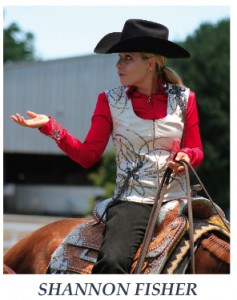 Shannon Fisher is the owner and designer of her own jewelry line, Halt + Rein. She is also the wife of well-known AQHA horse trainer, Alan Fisher, and an accomplished equestrian herself. Fisher has been working on her jewelry pieces since 2006, and in 2009 she created a small business out of it. Today, Fisher sells her jewelry to her fellow AQHA exhibitors in an effort to combine her work and passion. However, most recently, her pieces have also been sold in a number of specialty boutiques and been featured on television shows including the Queen Latifah Show, Single Ladies on VH1, and on the Hallmark Channel for a “What to Wear for New Years Eve” segment. Fisher explains how she manages to run her up-and-coming business and still ride every day. “I’m always on the go,” she says. “It’s not uncommon for us to be on the road for a competition and for me to be in the back seat of the truck making jewelry. Otherwise, I feel like I’m wasting time.”
Shannon Fisher is the owner and designer of her own jewelry line, Halt + Rein. She is also the wife of well-known AQHA horse trainer, Alan Fisher, and an accomplished equestrian herself. Fisher has been working on her jewelry pieces since 2006, and in 2009 she created a small business out of it. Today, Fisher sells her jewelry to her fellow AQHA exhibitors in an effort to combine her work and passion. However, most recently, her pieces have also been sold in a number of specialty boutiques and been featured on television shows including the Queen Latifah Show, Single Ladies on VH1, and on the Hallmark Channel for a “What to Wear for New Years Eve” segment. Fisher explains how she manages to run her up-and-coming business and still ride every day. “I’m always on the go,” she says. “It’s not uncommon for us to be on the road for a competition and for me to be in the back seat of the truck making jewelry. Otherwise, I feel like I’m wasting time.”
The biggest challenge Fisher has found when trying to balance work and riding is simply finding the time to do everything. She explains, “I’m committed to making my business successful and taking it to the next level. However, at the level we show at, I believe you have to be 150% committed. Not only do I want to do well to represent myself, but I want to do well to represent my husband.” Nonetheless, Fisher says she enjoys maintaining this balance between work and riding. “I enjoy it. I definitely don’t think of it as a negative thing. I’m extremely fortunate that I have created a business where I can work at home. If I didn’t have Alan to get the horses so ready for me, it might be harder, but he takes good care of us. “
Fisher’s advice on maintaining a healthy balance between work and riding is as follows: “If you overanalyze and worry about how you’re going to pay for your horses to go to a show or how you will find the time to complete something you’re working on, you’re going to totally overwhelm yourself. Use your creativity, go with the flow, and you’ll be able to get it done.”
Stephanie Smith
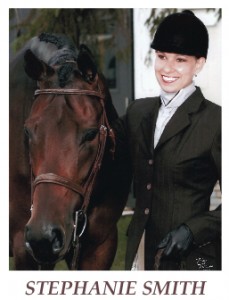 For the last fifteen years, Stephanie Smith has worked at Smith, Lewis, Chess & Co. LLP, a public accounting firm located in Uniontown, Pennsylvania. Not only does she work there as a Certified Public Accountant, she is also the Director of Technology and Systems Control, a Human Resource Manager, the Chief Operating Officer, and a partner in the firm. With such a huge number of responsibilities, one might assume that Smith has no time for herself, or horse showing, which she began when she was just seven years old.
For the last fifteen years, Stephanie Smith has worked at Smith, Lewis, Chess & Co. LLP, a public accounting firm located in Uniontown, Pennsylvania. Not only does she work there as a Certified Public Accountant, she is also the Director of Technology and Systems Control, a Human Resource Manager, the Chief Operating Officer, and a partner in the firm. With such a huge number of responsibilities, one might assume that Smith has no time for herself, or horse showing, which she began when she was just seven years old.
Still, Smith reveals that she has actually been quite successful at balancing her career and horse showing since 1998. She and her current horse, What a Detailed Diva, have been showing on the AQHA circuit since 2008, even though Smith has to work 45 to 60 hour workweeks year-round. Still, Smith is looking to take on yet another challenge. She has plans to start showing a new three year-old mare, The Next Diva, this year. Smith, who shows in hunter under saddle, equitation, and showmanship, says that despite her busy work schedule, she still makes it to nearly thirteen competitions a year. Also, not only is Smith balancing work and her riding career, she is doing it well. Some of her top titles include 2013 Reserve Congress Champion in Amateur Hunt Seat Equitation, 2012 AQHA High Point Amateur in Hunt Seat Equitation, and 2011 AQHA Reserve High Point Amateur in Hunt Seat Equitation.
Smith admits that such success doesn’t always come easy. For her, one of the most difficult challenges with balancing work and riding is finding the time to get everything done. “I have to make sure everything is taken care of at the office before I can leave for a show,” she says. “I was supposed to attend a show this past September but had to cancel last minute due to my workload. This is rare, but it does happen.” Nonetheless, Smith claims that overall, having to balance work with riding has its benefits. She explains, “Riding for me is a stress reliever and a way for me to escape the pressures of work. I’m lucky because my horse is only 45 minutes away, so I can ride often. Also, this past year I went through a divorce and riding was a tremendous help in keeping my sanity!”
Smith’s advice for almost-amateur exhibitors is this: “During some points in your life, you will be able to show more often than others. If you don’t attain the goals you set this year because of your career or other factors, there is always next year.”
Kelly Kay Johnsrud
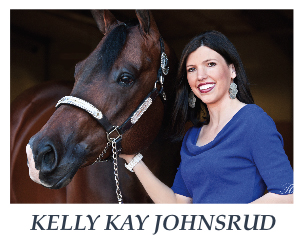 Kelly Kay Johnsrud works as an Independent Sales Director for Mary Kay, an internationally respected skin care, makeup, and body care line. She has also been riding horses her entire life and has achieved accolades including Congress Championships, National High Point awards, and World Championship titles. Today, Johnsrud not only sells Mary Kay products to clients, but it’s also her job to train, educate, and mentor other Mary Kay consultants. She first started her business with Mary Kay when she was just 18. Johnsrud knew work might interfere with her riding. “One of the main reasons I selected the career and company I did was because of the flexibility,” she says. “I wanted to be an independent contractor. A flexible schedule is crucial in order to compete at a high level. I also knew I needed a great income, so I wanted a business that had no limits on my earning potential. Basically, I wanted the best of both worlds.” Johnsrud proves that it is possible to have just that. She explains, “I consider it a privilege to ride and show Quarter Horses, and I’m so grateful to have a career that has afforded me this passion.”
Kelly Kay Johnsrud works as an Independent Sales Director for Mary Kay, an internationally respected skin care, makeup, and body care line. She has also been riding horses her entire life and has achieved accolades including Congress Championships, National High Point awards, and World Championship titles. Today, Johnsrud not only sells Mary Kay products to clients, but it’s also her job to train, educate, and mentor other Mary Kay consultants. She first started her business with Mary Kay when she was just 18. Johnsrud knew work might interfere with her riding. “One of the main reasons I selected the career and company I did was because of the flexibility,” she says. “I wanted to be an independent contractor. A flexible schedule is crucial in order to compete at a high level. I also knew I needed a great income, so I wanted a business that had no limits on my earning potential. Basically, I wanted the best of both worlds.” Johnsrud proves that it is possible to have just that. She explains, “I consider it a privilege to ride and show Quarter Horses, and I’m so grateful to have a career that has afforded me this passion.”
Johnsrud has even found a way to make the balance between work and riding fun. She explains, “I have no territories in my business, which is a huge advantage,” she says. “I built my customer base all over the country while on the horse show circuit. This past year, I was also the Official Beauty Sponsor of the Reichert Celebration. We offered complimentary show makeovers for the competitors. It was a huge success. We even put Mary Kay lipstick on an impressive list of trainers and competitors for charity. I have lots of priceless photos of guys wearing bright red lipstick! Did I mention that my job is really fun?”
Even when balancing work and riding seems overwhelming, Johnsrud never gives up. Instead, she simply makes adjustments. She explains, “There are certainly times that one schedule takes precedence over the other. I have never completely quit either one, but sometimes I lighten my show schedule up to work on big goals in my business. Also, I have definitely sprinkled my business around my horse show schedule and goals all these years.”
Kelly’s advice for balancing work and riding is that “there’s always time for something that enriches your life. It’s important to be clear on your goals and work backwards to create a plan and strategy to achieve them. Also, you always need a great support system when working toward a big goal.”
These exhibitors prove that even though it may not always be easy, it is possible, and often even fun and rewarding, to balance work with a full-time job. Although work may interfere with your riding schedule at times, these exhibitors illustrate that with a little bit of planning ahead and flexibility, you don’t have to sacrifice a successful career just to show your horse. In the same way, you don’t have to sacrifice your riding career just because you started a professional career. In closing, it really is possible to balance a career and your competitive passions at any age, and, as Baird states, it’s even worth the extra effort.
Click here to read the complete article










